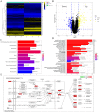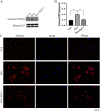Glucocorticoids induce osteonecrosis of the femoral head in rats via PI3K/AKT/FOXO1 signaling pathway
- PMID: 35529482
- PMCID: PMC9074886
- DOI: 10.7717/peerj.13319
Glucocorticoids induce osteonecrosis of the femoral head in rats via PI3K/AKT/FOXO1 signaling pathway
Abstract
Background: Steroid-induced osteonecrosis of the femoral head (SONFH) is a disorder that causes severe disability in patients and has a high incidence worldwide. Although glucocorticoid (GC)-induced apoptosis of osteoblasts is an important cytological basis of SONFH, the detailed mechanism underlying SONFH pathogenesis remains elusive. PI3K/AKT signaling pathway was reported to involve in cell survival and apoptosis.
Objective: We explored the role of PI3K/AKT/FOXO1 signaling pathway and its downstream targets during glucocorticoid -induced osteonecrosis of the femoral head.
Methods: We obtained gene expression profile of osteoblasts subjected to dexamethasone (Dex) treatment from the Gene Expression Omnibus (GEO) database. Differentially expressed genes (DEGs) were screened out and functional enrichment analysis were conducted by bioinformatics analysis. In vitro, we analyzed Dex-induced apoptosis in MC3T3-E1 cells and explored the role of PI3K/AKT/FOXO1 signaling pathway in this phenomenon by employing siRNA-FOXO1 and IGF-1(PI3K/AKT agonist). Finally, we verified our results in a rat model of SONFH.
Results: In Dex-treated osteoblasts, DEGs were mainly enriched in the FOXO signaling pathway. Dex inhibited MC3T3-E1 cell viability in a dose-dependent effect and induced apoptosis by increasing the expression levels of FOXO1, Bax, cleaved-Caspase-3, and cleaved-Caspase-9, while reducing the expression of Bcl-2. Notably, these results were reversed by siRNA-FOXO1 treatment. Dex inhibited PI3K/AKT signaling pathway, upregulated FOXO1 expression and increased FOXO1 nuclear translocation, which were reversed by IGF-1. Compared to normal rats, the femoral head of SONFH showed increased expression of FOXO1, increased number of apoptotic cells, and empty osteocytic lacunas, as well as decreased bone tissue content and femoral head integrity. Significantly, the effects of GC-induced SONFH were alleviated following IGF-1 treatment.
Conclusion: Dex induces osteoblast apoptosis via the PI3K/AKT/FOXO1 signaling pathway. Our research offers new insights into the underlying molecular mechanisms of glucocorticoid-induced osteonecrosis in SONFH and proposes FOXO1 as a therapeutic target for this disease.
Keywords: Apoptosis; Dexamethasone; FOXO1; Glucocorticoids; Osteoblast; PI3K/AKT; SONFH.
©2022 Sun et al.
Conflict of interest statement
The authors declare there are no competing interests.
Figures







Similar articles
-
Proanthocyanidins Inhibit Osteoblast Apoptosis via the PI3K/AKT/Bcl-xL Pathway in the Treatment of Steroid-Induced Osteonecrosis of the Femoral Head in Rats.Nutrients. 2023 Apr 18;15(8):1936. doi: 10.3390/nu15081936. Nutrients. 2023. PMID: 37111155 Free PMC article.
-
Echinacoside alleviates glucocorticoid induce osteonecrosis of femoral head in rats through PI3K/AKT/FOXO1 pathway.Chem Biol Interact. 2024 Mar 1;391:110893. doi: 10.1016/j.cbi.2024.110893. Epub 2024 Feb 7. Chem Biol Interact. 2024. PMID: 38336255
-
Dexamethasone induces osteoblast apoptosis through ROS-PI3K/AKT/GSK3β signaling pathway.Biomed Pharmacother. 2019 Feb;110:602-608. doi: 10.1016/j.biopha.2018.11.103. Epub 2018 Dec 8. Biomed Pharmacother. 2019. PMID: 30537677
-
Animal models of steroid-induced osteonecrosis of the femoral head-a comprehensive research review up to 2018.Int Orthop. 2018 Jul;42(7):1729-1737. doi: 10.1007/s00264-018-3956-1. Epub 2018 Apr 28. Int Orthop. 2018. PMID: 29705870 Review.
-
Pathological mechanisms and related markers of steroid-induced osteonecrosis of the femoral head.Ann Med. 2024 Dec;56(1):2416070. doi: 10.1080/07853890.2024.2416070. Epub 2024 Nov 12. Ann Med. 2024. PMID: 39529511 Free PMC article. Review.
Cited by
-
Study on the Mechanism of Mesaconitine-Induced Hepatotoxicity in Rats Based on Metabonomics and Toxicology Network.Toxins (Basel). 2022 Jul 14;14(7):486. doi: 10.3390/toxins14070486. Toxins (Basel). 2022. PMID: 35878224 Free PMC article.
-
Proanthocyanidins Inhibit Osteoblast Apoptosis via the PI3K/AKT/Bcl-xL Pathway in the Treatment of Steroid-Induced Osteonecrosis of the Femoral Head in Rats.Nutrients. 2023 Apr 18;15(8):1936. doi: 10.3390/nu15081936. Nutrients. 2023. PMID: 37111155 Free PMC article.
-
Analysis of the Potential Angiogenic Mechanisms of BuShenHuoXue Decoction against Osteonecrosis of the Femoral Head Based on Network Pharmacology and Experimental Validation.Orthop Surg. 2024 Mar;16(3):700-717. doi: 10.1111/os.13970. Epub 2024 Jan 31. Orthop Surg. 2024. PMID: 38296807 Free PMC article.
-
Exploring the Potential of Moringa oleifera in Managing Bone Loss: Insights from Preclinical Studies.Int J Med Sci. 2025 Jan 21;22(4):819-833. doi: 10.7150/ijms.103241. eCollection 2025. Int J Med Sci. 2025. PMID: 39991771 Free PMC article. Review.
-
Identification and validation of endoplasmic reticulum stress-related genes in patients with steroid-induced osteonecrosis of the femoral head.Sci Rep. 2024 Sep 16;14(1):21634. doi: 10.1038/s41598-024-72941-8. Sci Rep. 2024. PMID: 39284931 Free PMC article.
References
-
- Caplan A, Fett N, Rosenbach M, Werth VP, Micheletti RG. Prevention and management of glucocorticoid-induced side effects: a comprehensive review: a review of glucocorticoid pharmacology and bone health. Journal of the American Academy of Dermatology. 2017;76(1):1–9. doi: 10.1016/j.jaad.2016.01.062. - DOI - PubMed
Publication types
MeSH terms
Substances
LinkOut - more resources
Full Text Sources
Medical
Research Materials
Miscellaneous

